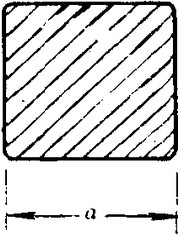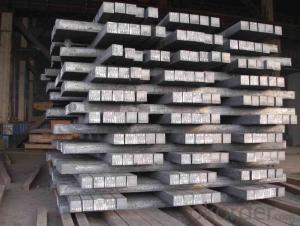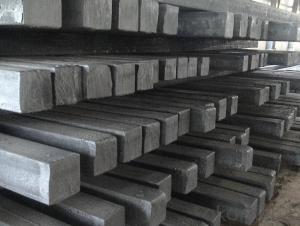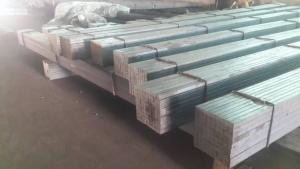Hot rolled square bar
- Loading Port:
- China Main Port
- Payment Terms:
- TT OR LC
- Min Order Qty:
- -
- Supply Capability:
- -
OKorder Service Pledge
OKorder Financial Service
You Might Also Like
-Standard: GB,
-Grade: Q195 or equivalent.
-Chemical Composition:
Standard | Grade | Element (%) | ||||
GB | Q195 | C | Mn | S | P | Si |
0.06~0.12 | 0.25~0.50 | ≤0.050 | ≤0.045 | ≤0.30 | ||
Measures of HR Square Bar (small measures):

(Section of HR Square Bar)
-Length of a side and Theoretical weight of Square Bar.
Length of a side(mm) | Theoretical weight(kg/m) | Length of a side(mm) | Theoretical weight(kg/m) |
7 | 0.385 | 22 | 3.80 |
8 | 0.502 | 24 | 4.52 |
9 | 0.636 | 25 | 4.91 |
10 | 0.785 | 26 | 5.30 |
11 | 0.950 | 28 | 6.15 |
12 | 1.13 | 30 | 7.06 |
13 | 1.33 | 32 | 8.04 |
14 | 1.54 | 34 | 9.07 |
15 | 1.77 | 36 | 10.17 |
16 | 2.01 | 38 | 11.24 |
17 | 2.27 | 40 | 12.56 |
18 | 2.54 | 42 | 13.85 |
19 | 2.82 | 45 | 15.90 |
20 | 3.14 | 48 | 18.09 |
21 | 3.46 | 50 | 19.63 |
Notes:
1, The theoretical weights in the list, base on the density of 7.85 g/cm3.
2, Formula for theoretical weight of Square bar: (length of a side)2 * 0.00785
3, The numbers with *mean that they are not regular or we don’t offer them.
-Regular length of Square Bar:
Steel | Length of a side (mm) | Length of steel (m) |
Normal steel | < 25 | 4~10 |
> 25 | 3~9 | |
Steel of high quality | All measure | 2~6 |
Tool steel >75 | 1~6 |
Usage/Applications of HR Square Bar:
-The Square Bar is normally used as structure steel.
-Row material for other structure steel like steel angles, channels, I-beams, H-beams, etc…
Packaging & Delivery of HR Square Bar:
-Packing Detail: The products can be packed in bundles by steel wires.
-Marks: We make tag marks and color marks. The tag marks with white background and red company logo will be tied up to each bundle of the products. The information is usually including basic information of products and company and other information requested by customers. As for color marks, we will paint both ends of bundles to make sure that it will be more convenient for customers to distinguish them from other products.
-Delivery Detail: 30~45 working days after receive buyer’s T.T. or L/C.
Transportation:
-The products can be delivered by bulk vessel or by container. As for container, products with the length of 6m will be loaded in 20’ container, with 9m or 12m, in 40’ container.
-The maximum quantity of loading of container is 25 tons.
-The products are usually transported to the nearest port from the production place.
- Q:How do you use a steel square to determine the angle of a compound miter bevel cut?
- To use a steel square to determine the angle of a compound miter bevel cut, you will need to follow a few steps. First, place your steel square on the workpiece, ensuring that one of the arms is aligned with the edge of the material. This arm will act as the reference for measuring the angle. Next, adjust the steel square to the desired angle for the miter cut. You can accomplish this by rotating the square until the desired angle is achieved. Once the steel square is set at the desired angle, mark the angle on the workpiece using a pencil or a marking knife. This will serve as a guide when making the cut. After marking the angle, set up your compound miter saw or other cutting tool according to the marked angle. This will ensure that the cut is made accurately. Finally, carefully make the cut along the marked line, ensuring that the workpiece is securely held in place to prevent any movement or accidents. Double-check the angle of the cut to ensure accuracy before proceeding with the project.
- Q:How do you use a steel square to check the flatness of a surface?
- In order to check the flatness of a surface using a steel square, it is important to have a reliable and accurate steel square. This tool consists of a ruler-like blade and a perpendicular handle. Here is a step-by-step guide on how to proceed: 1. Make sure that both the surface you wish to check and the steel square are clean and free from any debris or dirt that could impact the accuracy of the measurement. 2. Position the steel square on the surface you want to check, ensuring that one edge of the square is aligned with the surface. 3. Examine the contact between the blade of the steel square and the surface. If the entire length of the blade is in contact with the surface without any gaps or daylight visible, it indicates that the surface is flat. 4. Move the steel square along different areas of the surface, examining for any inconsistencies. If you notice any gaps or daylight between the blade and the surface, it suggests that the surface is not flat in that specific area. 5. Pay attention to the gaps or daylight that you observe. If the gaps are consistently the same size, it may indicate that the surface has a slight bow or warp. However, if the gaps vary in size, it could suggest a more significant irregularity or unevenness in the surface. 6. Take note of any areas where the surface is not flat. This information can be useful in determining the extent of the flatness issue and planning any necessary corrective measures. Keep in mind that using a steel square is not a foolproof method for measuring flatness, especially for large surfaces. It is more suitable for smaller projects or initial assessments. For more precise measurements, specialized tools such as straight edges or laser levels may be required.
- Q:How do you use a steel square to measure board lengths at different angles?
- To use a steel square to measure board lengths at different angles, you would start by placing the square's long side (blade) against the edge of the board. Next, rotate the square until the desired angle aligns with the edge of the board. Once aligned, mark the board along the shorter side (tongue) of the square. Finally, measure the distance from the marked point to the end of the board to determine the length at the specific angle.
- Q:How do you use a steel square to measure the thickness of a board?
- To measure the thickness of a board using a steel square, place the square on the edge of the board so that one arm is against the surface and the other arm is perpendicular to it. Slide the square along the edge until it touches the opposite surface. Take note of the measurement where the square intersects the edge of the board, which indicates its thickness.
- Q:Can a steel square be used for checking the plumbness of walls?
- Yes, a steel square can be used for checking the plumbness of walls.
- Q:How do you use a steel square to measure and mark 16.875-degree angles?
- To measure and mark angles of 16.875 degrees using a steel square, follow these instructions: 1. Begin by selecting the side of the steel square that will serve as your reference. Typically, the long side called the blade is the most precise for angle measurements. 2. Place the steel square on a level surface or workbench, ensuring proper alignment. 3. Identify the 90-degree angle on the steel square, usually indicated by a right angle symbol. This will be your starting point. 4. Locate the 45-degree angle on the steel square, typically marked by a diagonal line or a 45° symbol. 5. To measure and mark a 16.875-degree angle, you will need to find the midpoint between the 45-degree and 90-degree angles. Since 16.875 degrees is less than half of 45 degrees, it will be closer to the 90-degree angle. 6. Align the blade of the steel square between the 45-degree and 90-degree angles, ensuring it runs parallel to both lines. 7. Once the blade is correctly aligned, make a mark or draw a line at the point where it intersects with the steel square. 8. This mark or line will represent a 16.875-degree angle when utilized in your project or measurement. Always verify your measurements and employ appropriate tools for accuracy. A protractor or angle finder may also be useful in confirming the precision of your marked angle.
- Q:Can a steel square be used for setting up a radial arm saw?
- No, a steel square cannot be used for setting up a radial arm saw. A steel square is a measuring tool that is commonly used for checking right angles and drawing straight lines. It is not designed or suitable for setting up power tools like a radial arm saw. Setting up a radial arm saw requires specific tools and techniques. The saw must be properly aligned and calibrated to ensure accurate and safe cutting. This involves adjusting the blade height, blade angle, and fence position among other factors. To set up a radial arm saw, it is recommended to use tools and accessories that are specifically designed for this purpose. This may include a digital angle gauge, a dial indicator, a miter gauge, or a precision fence. These tools are designed to provide accurate measurements and adjustments for the specific requirements of a radial arm saw. Using a steel square or any other inappropriate tool for setting up a radial arm saw can lead to inaccurate cuts, increased risk of injury, and potential damage to the saw or workpiece. It is always best to follow the manufacturer's instructions and use the appropriate tools for the task at hand.
- Q:Can a steel square be used for checking the squareness of a circular saw blade?
- No, a steel square cannot be used for checking the squareness of a circular saw blade. A steel square is designed specifically to measure right angles, not the squareness of a circular object. The circular saw blade is a round object, and its squareness refers to the alignment of the blade's teeth with the cutting plane. To properly check the squareness of a circular saw blade, specialized tools such as a dial indicator or a dedicated blade alignment gauge should be used. These tools are specifically designed to accurately measure the squareness of a circular saw blade and ensure precise and accurate cuts.
- Q:How does a steel square assist in laying out stairs?
- When it comes to laying out stairs, carpenters and builders rely heavily on the versatility of a steel square. This essential tool is specifically designed to provide accurate measurements and angles, making it invaluable in the construction process. Here are a few ways in which a steel square can assist in laying out stairs: 1. Rise and run determination: By utilizing the tongue and body of the steel square, builders can easily establish the rise and run of each step. Aligning the square with the stringer, the inclined board that supports the steps, allows for precise marking of the height (rise) and depth (run) of each step. 2. Angle setting: Safety and comfort are paramount when constructing stairs, and the steel square's adjustable angle feature proves invaluable in achieving the desired slope. By adjusting the square to the required angle, builders can effortlessly mark and cut the stringers accordingly. 3. Squareness checking: Ensuring that the corners and angles of the stairs are precisely 90 degrees, or square, is crucial for stability and safety. The steel square can be utilized to check the squareness of the stringers and verify proper alignment. This step is essential in avoiding any potential issues with the staircase's stability and safety. 4. Measurement transferring: Another beneficial function of the steel square is its ability to transfer measurements accurately. For instance, when determining the width of the stairs, the square can be used to mark the measurement from the stringer onto the tread, the horizontal part of the step. This ensures consistency and accuracy throughout the layout process. In summary, a steel square is an indispensable tool for laying out stairs. Its ability to measure, mark angles, check squareness, and transfer measurements accurately is highly beneficial for carpenters and builders. By utilizing a steel square, professionals can construct stairs with precision and in compliance with safety standards.
- Q:Can a steel square be used for checking the alignment of floor joists?
- Yes, a steel square can be used for checking the alignment of floor joists. The right angle of the steel square can help ensure that the joists are properly aligned and perpendicular to the walls or other structural elements.
1. Manufacturer Overview |
|
|---|---|
| Location | |
| Year Established | |
| Annual Output Value | |
| Main Markets | |
| Company Certifications | |
2. Manufacturer Certificates |
|
|---|---|
| a) Certification Name | |
| Range | |
| Reference | |
| Validity Period | |
3. Manufacturer Capability |
|
|---|---|
| a)Trade Capacity | |
| Nearest Port | |
| Export Percentage | |
| No.of Employees in Trade Department | |
| Language Spoken: | |
| b)Factory Information | |
| Factory Size: | |
| No. of Production Lines | |
| Contract Manufacturing | |
| Product Price Range | |
Send your message to us
Hot rolled square bar
- Loading Port:
- China Main Port
- Payment Terms:
- TT OR LC
- Min Order Qty:
- -
- Supply Capability:
- -
OKorder Service Pledge
OKorder Financial Service
Similar products
New products
Hot products
Related keywords




























